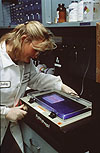Naming the Vietnam Unkown
A New Research Initiative
An AFDIL scientist analyzes amplified mtDNA .
In 1991, the United States Department of Defense recognized the value of DNA testing and founded the Armed Forces DNA Identification Laboratory (AFDIL) within the Armed Forces Institute of Pathology. AFDIL's mission includes the support of the U.S. Army Central Identification Laboratory, Hawaii (CILHI) in their identification of skeletal remains of U.S. service members. AFDIL's research has focused on the extraction of mtDNA from bone where the DNA has been damaged by environmental insults, bacteria, fungi, and decay. This type of bone is termed "ancient" although it may be only a few years old.
This specimen, an upper arm bone from a Civil War soldier, was used in AFDIL's early studies in extracting mtDNA from ancient bone.
One of AFDIL's early studies used Civil War bone samples from the collections of the National Museum of Health and Medicine of the Armed Forces Institute of Pathology. This study proved that mtDNA could be extracted and then copied - or amplified - using the polymerase chain reaction (PCR) technique from bone more than 125 years old. In 1995 due to AFDIL's and other labs' success with the extraction of mtDNA from ancient bone, the Defense Science Board approved the use of mtDNA sequencing for the identification of associated and unassociated skeletal remains. Since then, AFDIL has contributed to the successful identification of over 150 missing service members from Vietnam, Korea, and World War II.
A small piece of the upper arm bone used to extract the mtDNA sequence for X-26






